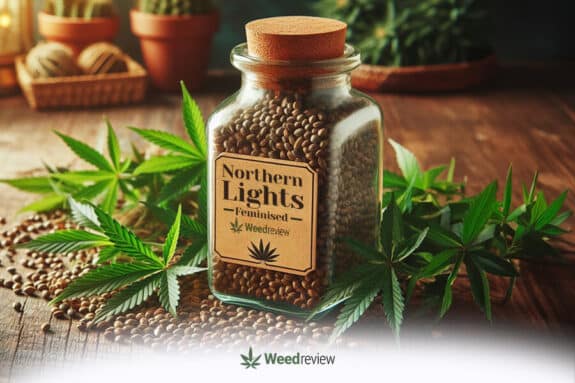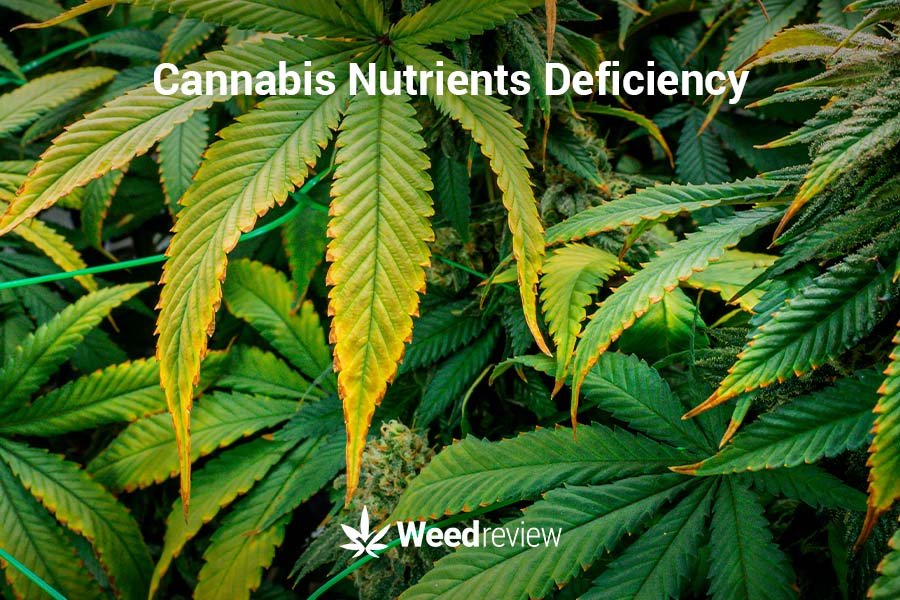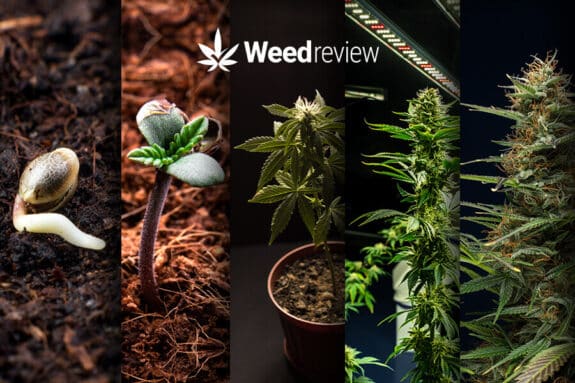
Cannabis Nutrient Deficiencies: Leaf Chart, Identification, Common Fixes

Table of Contents
Marijuana plants – be they for medical or personal use – need a combination of things to grow beautifully. This includes a healthy diet of nutrients and minerals, good surroundings, and plenty of love and care. If this is not right, the plant will show visual signs with yellowing leaves, weaker stems, and poor growth.
If their basic needs are not met—whether it’s temperature and humidity, growing medium, proper lighting, water, pH levels, or a well-rounded diet—they are prone to developing problems like nutrient deficiencies. This is not good; if it is not treated quickly, the entire plant can die.
Growing cannabis is an art that takes plenty of practice and trial and error. Its success lies in mastering the basics.
In this guide, we explore the different deficiencies of nutrients in cannabis. We will look at how to identify the signs and what you can do to fix them.
What is marijuana nutrient deficiency?
Nutrient deficiencies occur when plants do not get the right amount of nutrients for their growth and development.
Also known as nutes, they are needed for important processes in the plant, like making food through photosynthesis and activating enzymes to make buds. When the plant doesn’t have enough of one or more nutrients, it shows signs that something is not right. Too much nutrients can also cause problems (nutrient burn/nutrient lockout).
Cannabis has different nutrient requirements in the vegetative and flowering stages. If there is an imbalance in the diet, the plants will not bloom properly. This leads to lower yields, poor quality of buds, and exposure to pests and mould.
Before we get to the symptoms, there are two things we need to know:
Macronutrients v micronutrients
Macronutrients are must-have elements needed by cannabis in large quantities.
The macronutrients are nitrogen (N), phosphorus (P), and potassium (K). Many growers refer to them as N-P-K, and these are essential. Standard fertilisers in the market generally feature a mix of these. Growing marijuana also requires Calcium (Ca), Magnesium (Mg), and sulfur (S) in the soil.
On the other hand, micronutrients are essential minerals needed in smaller quantities.
They are like vitamins and minerals we eat to be healthy. We do not need a lot of them, but if we do not get them at all, we fall sick. Micronutrients include elements like iron (Fe), zinc (Zn), manganese (Mn), copper (Cu), boron (B), molybdenum (Mo), and chlorine (Cl).
If you want to get high-grade, medicinal cannabis, you need to get both nutrients – macro & micro – in the right amounts.
Mobile and immobile nutrients

Some nutrients in cannabis plants can move around within the plant when there’s a shortage. We call these mobile nutrients.
They are transferred from older leaves to newer parts of the plant, so the plant can keep on growing. For example, when a phosphorous shortage occurs, the plant ‘steals’ it from older leaves and sends it to the new ones. This leaves the older foliage looking sick.
On the other hand, some nutrients are immobile. This means they can’t move within the plant. When there’s a deficiency, the symptoms appear first in the new growth because the plant cannot send the nutrients from its current stock.
Identifying & fixing cannabis nutrient deficiencies: A visual guide
Cannabis plants tell us they are sick by giving us visual hints. A major one is the colour of the leaves and the overall appearance of the plant. Anything but green usually means a bad sign.

Yellowing leaves, brown spots, not growing properly, and twisted/curled fan blades indicate that your plant is sick; there is nutrient deficiency. It is then a matter of finding where the deficiency is happening and how it is moving to pinpoint the nutrient.
Nitrogen deficiency
Nitrogen (N) is found in the soil as nitrate. It is highly important as helps them grow and stay healthy. It helps make chlorophyll, create proteins, and divide cells.

Symptoms
Yellow leaves in the bottom part of the plant are a classic sign of nitrogen deficiency. The oldest and lowest leaves are affected first by this problem as it is a mobile nutrient.
They turn from green to pale green to yellow (known as chlorosis), wilting away and eventually dying. These yellow leaves may also turn brown, become soft and curled, and fold inwards before falling off. The yellowing will then move up the plant, destroying other leaves too.
The oldest leaves are affected first because the plant is moving the N from there to support newer growth.

A lack of nitrogen can lead to slow growth, smaller leaves, and a generally weak and thin appearance.
You should keep an eye out for nitrogen deficiency during the vegetative cycle or the start of the flowering phase. This is when your marijuana plants need the most N.
In the late flowering stage, it is completely normal to see these signs as the plant is pulling all the N from her leaves to make beautiful flowers. In fact, it is even preferable as too much nitrogen can prevent the buds from forming correctly.
How to fix
- Use nitrogen-rich fertilisers or add organic matter to the soil.
- Treat the plant with feather meal, fish-based meals, calcium nitrate, urine, and manure.
- Adjust the pH levels – 6.0 – 6.5 for better N absorption.
Phosphorus deficiency
Phosphorus is another necessary nutrient; it is the second of the major nutrients (N-P-K) required by cannabis.
It helps create energy for photosynthesis, promotes strong roots and stems, improves flower and seed production, protects against diseases, and supports overall growth.

Symptoms
Phosphorous (P) is also a mobile nutrient, which means the lower and older leaves are affected first by the deficiency. Leaves turn dark (dark green, purple, or blue shade) and take a shiny look.

Another sign of a lack of P is the leaves getting brown, purple, or copper-coloured spots and splotches (big marks). The affected leaves may thicken, curl, and feel stiff. If left untreated, the leaves will turn yellow.
The stems of the plant may show a bright red or purple colour.
Do note that some strains naturally grow purple or red stems, so if you are seeing them on their own, then it is not a problem.
Marijuana phosphorous deficiency is most commonly seen in the flowering stage as they need a lot of P to make dense, resinous buds.
How to fix
- Adjust the pH to the correct range of 6.2 – 7.0 in soil and 5.5 – 6.2 in hydroponic set-up. This ensures the conditions are optimal for phosphorous absorption.
- Check the temperature settings to ensure conditions are optimal and not below 15°C.
- Feed sources of phosphorous like fish mean, worm casting, crab shell, soft rock phosphate, and bone or blood meal.
Potassium deficiency
Potassium (K) is a vital nutrient for plants, essential for their growth, reproduction, and overall quality. It influences photosynthesis, energy production, water regulation, and nutrient absorption through the roots.

Symptoms
The tips and edges of the leaves turn brown or yellow, looking like burnt leaves. This is usually seen in older, lower leaves, but sometimes, it may be seen at the top of the plant. It is also common to see this burn pattern appear as pale, white, or bleached. Eventually, older leaves will turn yellow/bleached, starting from the tip and moving inwards.

Curling leaves are another sign of cannabis potassium deficiency. The tips of the blades will curl while the edges turn brown. The veins of the leaves will remain green.
Stretching or excessive height is another symptom. Plant growth slows down, leaves become smaller, and larger fan leaves may die (necrosis).
How to fix
- Ensure the grow lights are not too close to the plants, as this can cause a light burn and mimic K deficiency symptoms.
- Adjust the pH level; 5.5 – 6.5 is ideal for hydroponic setups, and 6.0 – 7.0 is suited for soil growth.
- Feed potassium-rich food like banana peel tea, wood ashes, organic seaweed, and potassium sulfate fertiliser.
Calcium deficiency
Calcium (Ca) helps in cell division, growth of new tissues, and maintaining cell wall structure. Just like how calcium helps our bones and physical form healthy, it does the same for the cannabis plants.

Symptoms
Calcium deficiency signs are seen in the new foliage or growing leaves of the plant because it is an immobile nute.
The curling of the new leaves and the presence of bronze or brown splotches are two common symptoms. Leaves may also have small brown spots and may undergo yellowing when the problem advances.

Fresh leaf blades may show irregular shapes and sizes, and new growth does not look healthy. The plant will display an overall stunted growth pattern. The stems and branches become weak and brittle.
Ca deficiency is generally expected in the flowering phase though it can happen anytime.
How to fix
- Fix the pH of the medium to 6.2 – 7.0 for soil and 6.2 – 6.5 for hydro/coco setups.
- Add calcium-rich supplements like Cal-Mag (calcium and magnesium) or dolomite lime.
Magnesium deficiency
Magnesium (Mg) is a crucial component of chlorophyll, the pigment that gives plants their green colour. It plays a central role in photosynthesis and helps metabolise sugars and transport nutrients.

Symptoms
Symptoms of magnesium deficiency include older leaves turning from green to pale green and eventually yellow. The veins stay dark green; that is, the leaves show yellow spots between the veins (known as interveinal chlorosis).
Brown dots may also be seen on the leaves; if left untreated, the yellowing can spread to younger leaves. The discolouration starts at the tip of the leaves and then spreads towards the base.

With time, the leaves might curl upwards and turn crunchy and rough.
How to fix
- Use Epsom salts, which is a form of magnesium sulphate. Dissolve Epsom salts in water and feed them to the plants.
- Check and fix the pH.
- Add Cal-Mag supplement or dolomite lime.
Sulfur deficiency
Sulfur is necessary for the production of amino acids, proteins, and vitamins in cannabis. It supports the structure and functioning of marijuana plants and helps in disease resistance.

Symptoms
Sulfur (S) deficiency is quite rare. When it happens, the symptoms look similar to those of nitrogen deficiency.

The leaves in the middle or top of the plant turn light green to yellowish, while older leaves remain green. The same may be seen in the younger foliage. As the deficiency progresses, the entire plant can display a light green/yellow colour.
Another differentiating sign is the undersides of the leaves – they turn pinkish-red or orange. Unlike other deficiencies where yellowing starts at the leaf tips, sulfur deficiency starts at the base of the leaf and progresses towards the front.
How to fix
- Correct the pH levels of your soil or water to help your cannabis plants absorb sulfur properly.
- Add sulfur supplements to your soil or hydroponic system, like Epsom salts, gypsum, or other sulfur-containing fertilisers.
Iron deficiency
Iron (Fe) is a crucial micronutrient for cannabis, responsible for the process of chlorophyll production. It assists in energy production and nitrogen fixation.

Symptoms
Iron deficiency in cannabis plants presents as bright yellowing of new growth (it is an immobile nutrient) while older leaves remain green. The discolouring starts at the base of the leaves and moves outwards towards the edges.

This bright colouring in the upper part of the plant is so intense that it almost appears white. The freshest leaves will be yellow or white due to a lack of chlorophyll.
The veins of the leaves stay green while the area around them turns yellow. The plant may exhibit stunted growth, and, in severe cases, the yellow leaves may develop brown spots.
How to fix
- Adjust the pH of your soil or hydroponics solution to the optimal range for iron absorption (6.0 – 6.5 for soil, 5.5 – 6.5 for hydroponics).
- Avoid excess phosphorous (P) as it can lead to Fe cannabis deficiency.
- Use iron chelates or iron-rich supplements.
Boron deficiency
Boron helps in the proper formation of cell walls and assists in the metabolic processes of proteins and carbohydrates. It is also vital for the development of new growth cells, pollen germination, and fruit and seed development.

Symptoms
Boron (B) deficiency often affects the growing tips of cannabis plants, causing them to become thick and twisted. The new leaves and growth can grow incorrectly, slowly, or abnormally.

Leaves can show symptoms like yellowing, browning, or curling. In severe cases, the stems may weaken and become hollow or cracked. The whole plant may eventually sink lower and collapse.
This deficiency is usually rare unless the plant is not watered enough or is grown in a dry environment.
How to fix
- Flush the growing medium and adjust the pH of your soil or hydroponics solution to ensure proper B absorption.
- Use boric acid – add one teaspoon of the acid to 4 litres of water and feed it to the plant.
Manganese deficiency
Manganese (Mn) is an essential nutrient for cannabis, supporting photosynthesis, nutrient absorption, and enzymatic reactions.

Symptoms
Manganese deficiency may resemble iron deficiency.

It is seen in newer, fresher growth where the leaves turn yellow and then brown before dying off. The yellowing starts at the base.
The symptoms include yellowing of leaves with the veins also turning yellow. Tan or brown spots may appear on the leaves and have a “checkered” appearance. Mottling of the leaves is also common.
How to fix
- Adjust the pH levels for Mn absorption. For soil, the pH should be between 6.0 – 6.5, and for hydroponics, it should be between 5.5 – 6.0.
- Supplement your plants with manganese through a foliar spray or by using a manganese-specific fertiliser.
Zinc deficiency
Zinc (Zn) is vital for cannabis plants as it aids in the formation of chlorophyll and carbohydrates. It also plays a role in the formation of auxins, a type of growth hormone.

Symptoms
The symptoms generally appear on the newer leaves first since it is an immobile nutrient.

New leaves may become narrow and distorted, and the plant does not grow well enough vertically. New leaves are crowded together as there is less space between them at the nodes. The new growth is not as lively as the older foliage; it looks like the plant is not trying hard enough to grow.
Zinc deficiency typically shows as yellowing or whitening between the veins of the top leaves (interveinal chlorosis). The yellowing starts at the edges of the tips & moves towards the base.
How to fix
- Optimise the pH of your growing medium to enhance zinc absorption.
- Apply a zinc-containing fertiliser or foliar spray.
Molybdenum deficiency
Molybdenum (Mo) is necessary for the conversion of inorganic phosphates to organic forms in the plant. It also assists in the formation of legume nodules and aids in the metabolisation of nitrogen.

Symptoms
Molybdenum deficiency appears in the middle of the plant and progresses upwards. The problem is rare.

A common sign is discoloured leaves. In severe cases, the leaves may exhibit an unusual orange, pink or red colour. The edges will have a brown, burnt shade, while the centre of the leaves will be red/orange.
Leaf curling and slowed growth may also occur.
How to fix
- Adjust the pH level of your soil or water to the appropriate range for molybdenum absorption.
- Prune dead (necrotic) growth.
Fixing & preventing nutrient deficiency: A 4 Point Approach
You can give your plants all the nutrients regularly, but they will simply not use them if the surrounding conditions are not right. The most important ones are soil acidity, feed, and watering.
When you start growing cannabis, there are a few things you can do from the very beginning to reduce the chances of nutrient deficiencies.
Maintain a healthy pH
Marijuana plants grow well in slightly acidic soil. On the pH scale (an indication of how acidic or basic (alkaline) something is), this means a range of 6.0 – 7.0. Since the pH levels vary across different regions, farmers should check the pH of the soil before planting the seedlings.
Each nutrient has a specific pH range where it is most readily available. If the pH is too high or too low, plants will not get that nute needed for healthy growth and flowering.
The pH of the soil can change as you add nutes. Doing it in the right amount- using the right supplement mixture – causes healthy absorption. This also helps growers avoid nutrient lockout – a condition where the plant is unable to absorb the minerals because there is too much of it.
When you see signs of deficiency, you should first check the pH of your soil and adjust it to the optimal range.
- Add alkaline mixes like caustic soda or potash if the soil is too acidic.
- Add acidic substances like vinegar mixture if it is alkaline.
A soil test can give you details about the nutrients present in the growing medium to make precise adjustments.
Flush the soil
Flushing the medium is a practice of resetting the nutrients in the soil. By passing supplement-free, pH-neutral water a few times, the leftover nutrient buildup is removed from the roots and the soil, thus starting from scratch.
When you flush, you make the plant absorb any nutes left in the soil. This is a bit like fasting for humans when they push the body to utilise its energy reserves.
Growers follow flushing in three instances:
- Pre-harvest: Flushing the plant two weeks before harvesting can greatly improve the quality of the flowers. The roots take up all the nutrients stored within themselves and put them to use. If they are not used or more nutrients are added, it can lead to poor-quality buds.
- Changes in the growth cycle: Nutrient needs are different in flowering and vegetative phases. Cleansing the soil before moving to a new stage is a nice way of cleaning the slate and setting the foundation for the next set of nutrients.
- Nutrient lockout: If the soil pH is too high or low, or if there is an imbalance of nutes, then you need to flush the system (a reset of the soil) as the roots cannot absorb the minerals. Add a new batch of balanced nutrients after flushing.
Feed the right food
Most standard fertilisers include the holy trinity of N-P-K (Nitrogen, Phosphorous, Potassium) and other macronutrients. Many of these, however, may not have the necessary micronutrients like iron, zinc, copper, and boron. Even though these are needed in small quantities, they are essential to make proper flowers. Growers must look at what nutrients they are buying and make sure they have everything they need.
When feeding the plants, keep in mind:
- Right ratios of the nutrients: Too much of one nutrient can cause a deficiency of others. The way to manage this is by using the right ratios – which will need some research. For N-P-K, the ideal ratio is 3:1:1 for the growth stage; that is, the fertiliser must have 30% of nitrogen, 10% phosphorous, and 10% potassium in the mix.
- Right amounts: Too many nutrients can lead to nitrogen lockout, while too little leads to deficiencies. The macro and micronutrients must be supplied timely depending on the stage of the growth cycle.
Do not overwater
Too much water can cause the roots to ‘drown’ and suffocate. The roots breathe in air and absorb vitamins and nutrients. Cannabis plants show this with drooping/bent leaves soon after watering.
A good rule of thumb is to water less often. Watering every 2-3 days should be enough if you are growing your plants correctly. Another way is by making sure the top of the soil is dry for about an inch (knuckle deep) before you decide to water.
Overwatering is generally not an issue with the hydroponic setup.
Conclusion
Yellowing of leaves is a definite sign that your plant is suffering from a deficiency. Identifying which part of the plant it happens – older, bottom growth or fresher, top growth – can reduce your options.
Similarly, checking how the yellowing is spreading – from the edges to the base or from the stems to the tips of the leaves – can help your diagnosis further. The last step is to check for spots and necrosis – whether it is massive, small, or coloured.
Remember that in the late flowering stage/soon before harvesting, it is completely natural and preferred for some of the leaves to turn yellow. That’s just your plant directing all the nutrients towards flower production.
In a majority of cases, the problem can be fixed (and prevented) by maintaining the right acidity in the soil. Combine that with a healthy, nutrient-rich diet, you will soon be on your way to high-quality, consistent yields.


